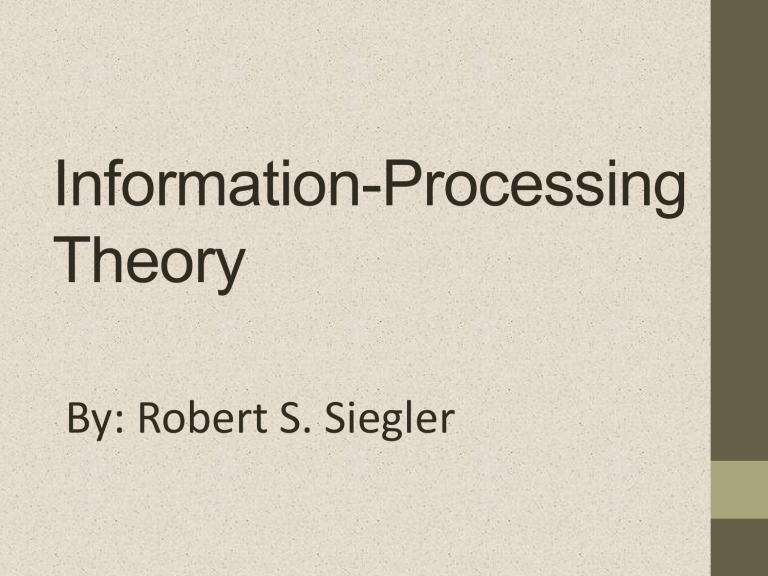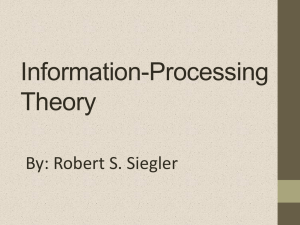
Information-Processing Theory By: Robert S. Siegler Robert S. Siegler • Teresa Heinz Professor of Cognitive Psychology • B.A. in psychology from the University of Illinois in 1970 • Ph.D. in psychology from SUNY Stony Brook in 1974 Focus of his works: • Are on children's thinking, particularly their mathematical and scientific thinking. • He also specializes in the cognitive development of problem solving and reasoning in children. Information-Processing Theory This theory attempts to account for changes in a child's cognitive ability via interactions between the developing brain and the child's increasing knowledge of the world. It aims to: • help social learning theorists and others understand how humans learn and solve problems • to understand cognitive development in terms of how people of different ages process information (i.e., decode, encode, transfer, combine, store, retrieve it), particularly when solving challenging mental problems (Sternberg 2002, p. 462). He suggested that children's ability to reason improved with age, and that an older child is able to draw upon a greater variety of mental processes than a younger child. Infant Early Childhood preference for moderately complex stimuli, ability to classify objects attention span of a child is short, easily distracted,, limited knowledge because of lack of experience with variable stimulation more capable of focusing on Middle Childhood important information, and they are not distracted as easily as before, increasingly symbolic nature of thought and knowledge, Early Adolescence Late Adolescence ability to focus on one task for an hour or so is developed, basic skills such as writing and math are basically automatic, knowledge base is expanded in relation to school subjects and interests. ability to focus on tasks is extended to lengthy periods of time instead of an hour, knowledge has increased to become "extensive and somewhat integrated" • Siegler (1998) proposes that as children grow older, they develop progressively better rules and strategies for solving problems and for thinking logically. • Siegler notes that change can be both continuous and discontinuous, as described by a branch of mathematics called catastrophe theory. • “viewed from afar, many changes in children’s thinking appear discontinuous; when viewed from close up, the same changes often appear as part of a continuous, gradual progression” (Siegler, 1998, p.55) Key Components that are Involved in the Information Processing Theory Sensory Memory Working Memory Long-Term Memory • Information processing theorists liken the sensory input to humans to the input functions of a computer. The processes of thinking--perception, problem solving, and memory --are similarly compared to the computer's data reading, data processing, and storage capabilities. The actions taken by humans are likened to a computer output. • While the computer analogy is limited and limiting, information processing theory has provided a structure for the study of cognitive processes in children. Factors that can Influence The Processing of Information 1. Environment influences perception, and "perception of one's surroundings is essential for survival, the human species has undoubtedly evolved some biologically built in perceptual mechanisms" 2. Heredity can cause children to have mental illnesses that can cause mental developments to not happen at the normal rate. Information-processing theorists believe that all thinking is information processing. • Sources: • "Information Processing Theory". Encyclopedia of Childhood and Adolescence. FindArticles.com. 25 Jun, 2011. http://findarticles.com/p/articles/mi_g2602/is_0003/ai_2602 000322/ • McDevitt, T., & Ormrod, J. (2004). Child Development: Educating and Working with Children and Adolescents (2nd ed.). : Prentice Hall




